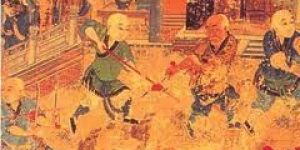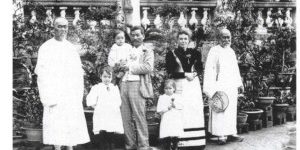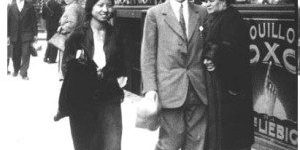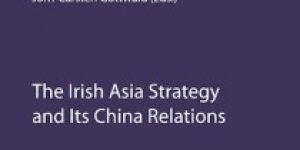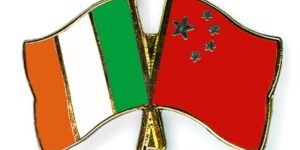Chapter 12: Ireland And The ASEM Process: The Case Of The Asia-Europe Foundation ~The Irish Asia Strategy And Its China Relations
No comments yet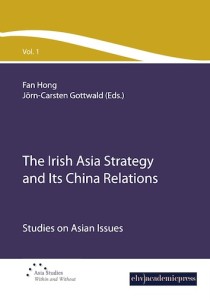 Ireland’s Asia Strategy is also embedded in the context of the wider relationship between the European Union and Asia. The relationship has been dramatically transformed from one of European political and economic dominance to a partnership of equals”. Dermot Ahern, Minister of Foreign Affairs, 2006.[i]
Ireland’s Asia Strategy is also embedded in the context of the wider relationship between the European Union and Asia. The relationship has been dramatically transformed from one of European political and economic dominance to a partnership of equals”. Dermot Ahern, Minister of Foreign Affairs, 2006.[i]
The inaugural Asia-Europe Meeting (ASEM)[ii] was convened in Bangkok, Thailand, in 1996, in a uniquely ambitious endeavour to build a multi-faceted platform where Asia and Europe could encounter each another in a modern context. This innovative model of engagement, with its emphasis on a flexible structure and informal dialogue, arose from a mutual recognition that the relationship between the two regions needed to be strengthened in light of the increasing interdependence in the economic, social and political spheres. The ASEM process as it has developed is based on an equal partnership and its activities are grouped into three pillars: political, economic and socio-cultural.
ASEM has its roots in the recognition in Asia and in Europe that the relationship between the two regions requires strengthening taking into account the growing importance of Asia and the integrating and enlarging Europe.
The three pillars of ASEM – political, economic, social/cultural/intellectual – have allowed for increasingly intensive engagement between the two regions since the outset of the process.
The process was driven largely from the Asian side with much of the initial impulse coming from Singapore. On the European side the push for improved interaction and greater co-operation came from the European Commission. Despite preoccupation with the implementation of the Maastricht Treaty provisions for the launching of the single currency programme, the European Commission responded positively and facilitated the inaugural meeting of the Heads of Government from the EU and East Asia in Bangkok. The fact of the meeting taking place was an important indicator of a readiness to engage more effectively in mutually beneficial interaction. Subsequent discussion between officials from both sides set out tentative procedures to be pursued.
In the words of Kishore Mahubani, the Singaporean diplomat charged by his Government with the task of convincing the European and Asian Governments to join in the initiative to develop ASEM, the rationale was simple. “There were three major growth centres in the world: North America, East Asia and Europe. In this triangular relationship, the connection between North America and Europe was strong, so too was the transpacific connection between North America and East Asia. The missing link was the relationship between Europe and East Asia”[iii]. Three years into the process, a review of the progress by a Vision Group of eminent persons was initiated. The report of the Vision Group makes interesting reading; the Group saw
“the gradual integration of Asia and Europe into an area of peace and shared development, a prosperous common living sphere in the 21st century, a sphere in which our knowledge, wealth, cultural heritage, democratic ideals, educational assets, intellectual aspirations are closely intertwined and exchanged without barriers or constraints. [The group] envision the active integration of our intellectual forces and a vibrant exchange of culture and the arts between Europe and Asia…[and] also visualise the progressive opening of markets with the eventual goal of free flow of goods and services by the year 2025”.[iv]
These ambitions stretch well beyond the conventional call for economic co-operation and friendly relations and reflect a deeper commitment to the development of civil links in the broadest sense. Implicit in the rhetoric is the hope for the globalisation of the social values that have characterised the European idea from the outset.
The Asia-Europe Foundation (ASEF) is the sole substantive institution of the ASEM process. ASEF was established in 1997 as a not-for-profit entity to function in accord wih the ‘Dublin Principles’ agreed during the Irish Presidency of the EU in the second half of 1996. The Dublin Principles charge ASEF with promoting cultural, intellectual and people-to-people exchanges between the two regions. As one of the founding countries, Ireland has been a strong supporter of the ASEM process and ASEF. Ireland’s participation in the activities of ASEF has been an important element in Ireland’s Asia Strategy. ”[v]
12.1 Contributing to the ASEM Process
The overall strategy of the ASEM process is approved by the biennial meetings of Heads of Government convened alternately in the EU and in Asia. The political dimension of the ASEM process is realised through an agenda determined by senior officials from the partner states meeting biannually, elements of the agenda being implemented by individual partner states. It is regrettable that the ASEM process itself does not have a basic secretariat even as the interaction expands and deepens and the process grows increasingly complex. The Vision Group identified the need for a point of co-ordination, a focus for continuity to ensure a continuing momentum in the ASEM process. The ‘virtual secretariat’ proposed at ASEM 5 in Hanoi in 2004 does not meet the need for effective coordination.
The principal element of the economic pillar of ASEM is the Asia Europe Business Forum (AEBF) which had its inaugural meeting in 1996 and is concerned with trade and investment. The Forum convenes annually, alternately in the EU and in Asia, with participation by experienced business persons from each of the partner states. Continuity in strategy and thinking between the meetings is, however, not helped by the absence of a secretariat. This inevitably leads to a lack of consistency and a lacuna in the follow up of agreed recommendations. The evident inadequacies of the present arrangements were identified by a core group of partner states which took the view in 2004 that the AEBF should convene biennially pending the putting in place of a ‘lean’ secretariat.
The social/cultural/intellectual pillar of ASEM is evident in ASEF. ASEF has a high quality secretariat in Singapore and is funded by voluntary contributions from the member states. With concentration on the younger people in the two regions, ASEF has put in place worthwhile programmes in accord with the Dublin Principles that can be seen also to fall in with the ambitions expressed by the ASEM Vision Group. The scope of the ASEF effort is small in relation to the evident need but ASEF has proven its worth and it is to be hoped that the experience of the first decade will prompt the ASEM Heads of Government at the ASEM 7 Summit in Beijing to seek a significantly expanded ASEF effort.
In the broader context, ASEM itself, being a non-statutory intergovernmental forum, seems to function in a largely informal environment with broad objectives relating to politics and administration, economic development through improved flows of trade and investment and enhanced social/intellectual/cultural exchange[vi]. The establishment of ASEF on a substantive basis within one year of the inaugural convening of ASEM was very important in reaching out to a wide audience and strengthening the interaction of the peoples of the two regions, in particular the younger generations on both sides.
At its inception in 1996, the ASEM process brought together 26 partners, namely, the 15 EU member states and the European Commission, together with ten Asian countries (Brunei, China, Indonesia, Japan, Korea, Malaysia, the Philippines, Singapore, Thailand, and Vietnam). At the ASEM 5 Summit, 10 new EU members and three Asian countries become part of the process: Cambodia, Cyprus, Czech Republic, Estonia, Hungary, Laos, Latvia, Lithuania, Malta, Myanmar, Poland, Slovakia and Slovenia. The subsequent round of ASEM enlargement in 2007 brought in India, Pakistan, Mongolia, Romania, Bulgaria and the ASEAN Secretariat. Thus, ASEF’s constituency increased to a total of 45 partners in a unique, informal structure which had the following key characteristics:
Informality (complementing rather than duplicating the work already being carried out in bilateral and multilateral fora);
– multidimensionality (devoting equal weight to political, economic and cultural dimensions);
– emphasis on equal partnership, eschewing any “aid-based” relationship in favour of a more general process of dialogue and co-operation, and;
– high-level focus, stemming from the ASEM Summits themselves.
Preparations for the ASEM 4 Summit that was held in Hanoi, Vietnam, in 2004, were co-ordinated by the Irish Presidency of the EU in preparing for the accession of 13 new countries, including Myanmar. The prospect of Myanmar’s entry into the ASEM process created some tensions between European and Asian countries. Under the Irish Presidency, the EU formulated the following requirements to be fulfilled by Myanmar as the basis for proceeding with the enlargement of ASEM:[vii]
– The release of Daw Aung San Suu Kyi and leaders of all political parties.
The National Convention procedures modified and a time frame established.
– The National League for Democracy and other elected representatives allowed participate freely in the National Convention.
The EU also conveyed a determination not to attend the Hanoi Summit should General Than Shwe, the leader of the military regime of Myanmar, participate, causing ASEAN members to retaliate by promising to block the entry of the 10 new EU member countries into the ASEM process. A last-minute compromise was reached with Myanmar agreeing to send a lower-ranked official to the meeting Myanmar was admitted into the partnership without addressing the EU’s concerns fully. However, discussions regarding human rights violations in the country as well as other political issues continue.
12.2 The Institutional Framework and Structure of ASEF
The ASEM Intergovernmental Dialogue is marked by its ever-growing list of subjects covered. ASEF has been mandated by ASEM to respond to significant international trends and emerging policies as set out in the Millennium Development Goals of the United Nations (UN), growing environmental challenges and the Development Co-operation Instrument of the EU. It is noted that the mandate of ASEF is intentionally wide, so that it can be politically responsive to changes and able to adjust its functions in a flexible way.
The governance of ASEF is a shared responsibility between the Board of Governors (BoG) and the Executive Office which is managed by the Executive Director and the Deputy Executive Director. The Board of Governors determines ASEF’s strategy, policies and priorities. It is responsible for the finance and budget of the Foundation and transmitting annual reports of its activities and finances to ASEM governments. The BoG is also responsible for the election of its Chair and Vice-Chair, the Executive Director and the Deputy Executive Director, as well as the appointment of any other Committee that it considers necessary.
Ireland’s representative on the ASEF Board of Governors is Dr. T P Hardiman who succeeded the late Sean Ronan, the distinguished public servant and the former Ambassador of Ireland to Japan. Dr Hardiman, who has a distinguished record in the public and private sectors in Ireland, maintains a presence in various EU representative groups including those concerned with EU Asian relationships.
12.2.1 Contributing to ASEF Activities
ASEF has been mandated to organise a large number of seminars, workshops and activities in four core areas, intellectual exchange, cultural exchange, people-to-people exchange and public affairs. ASEF is involved from the conceptualisation to the implementation stages of the projects, often acting as the secretariat of the series/project and in other cases is also consulted and provides substantial inputs on the themes and topics for discussion, as well as on the selection of participants and speakers.
The Intellectual Exchange programme brings together representatives from civil society in its broadest sense, including the business sector, and government officials to contribute to the creation of networks and to strategic thinning and policy debate on themes including international relations, environment, governance (including human rights, justice and democracy), and intercultural/interfaith dialogue.
The Cultural Exchange programme provides young artists and cultural professionals with a platform to encourage the exchange of techniques and the creation of networks and promotes cultural policy development in Asia and Europe.
The People-to-People Exchange programme strengthens youth networks, in particular among the next generation of leaders. Activities cover two main areas: educational exchanges, and cooperation and dialogues between youth and their organisations (e.g. Asia-Europe Young Political Leaders Symposium and Asia-Europe Young Entrepreneurs Forum. Cooperation and interaction between educational institutions, including those at third level, is increasingly featured in the work.
The Public Affairs programme provides publicity and press support for ASEF activities and seeks to raise public awareness of issues pertaining to Asia-Europe relations through media activities, such as television documentaries, public lectures, the use of the Internet (the ASEM Infoboard website), and the publication of newsletters and the high-quality academic Asia-Europe Journal.
In the past ten years of operation, ASEF has implemented over 310 projects, which have brought together more than 13,500 participants and reached out to an even wider audience in the countries of Asia and Europe.
To date, Ireland has contributed €520,000 Euro to ASEF’s operating funds and has hosted nine ASEF projects, the most recent being the Asia-Europe Forum for Young Photographers 2007 held in Dublin (IADT Dun Laoghaire) and Cork (Cork Institute of Technology) in November 2007, the 22nd Asia-Europe Lecture Tour which brought Professor Kenneth Chan from Hong Kong to Cork (Irish Institute of Chinese Studies) in February 2008.
In addition, under the Asia-Europe Environment Forum the first lecture series includes Ms. Ella Antonio visiting Dublin in May 2008 to deliver a lecture at the Institute of International & European Affairs.
In addition, Ireland has made an important contribution to the program content and the management of ASEF. Peter Ryan, a diplomat with good experience in Asia, was seconded in September 2006 by the Department of Foreign Affairs to the Executive Office at ASEF to take responsibility as Director of Intellectual Exchange.
12.3 Contributing to the Challenges Confronted by ASEF
As highlighted in the 2007 ASEF Evaluation Report commissioned by the EC, “ASEF is moving to exploit its potential as an information hub, also giving visibility to and creating synergies with initiatives promoted by the EC and the other ASEM partners”.[viii] Indeed, the impact of ASEF activity over the last 10 years can be measured through the thousands of participants who have attended seminars, conferences, workshops, summer schools, etc. Similarly, many thousands of readers have benefited from the books, journals, studies and papers produced for or as a result of ASEF-administered events.
12.3.1 Visibility
The 2006 ASEM 6 Summit held in Helsinki, Finland, highlighted the need to improve visibility and establish an effective communication strategy for ASEM. The visibility of ASEF is intrinsically linked to the ASEM process, and as such, ASEF has successfully developed highly managing since 2005, is a key official medium for the visibility of the ASEM process. There were some 40,000 visitors to the ASEM Infoboard website in 2007. However, more needs to be done if the Infoboard is to be the premier source of information on the ASEM process.
12.3.2 Financial Sustainability
Financial sustainability has been an area of concern for ASEF. Since its establishment, ASEF has struggled with unpredictable financial contributions from ASEM partners. The initial expectations that it would become sustainable through the establishment of an Endowment Fund were not fulfilled and were judged five years ago to be unrealistic. The EU enlargement in 2004 brought a consequential enlargement to 45 members in ASEF. Taking into account that the enlarged ASEF included many less developed states, Ireland has been active in promoting the funding of ASEF and has increased the annual Irish contribution to €100,000 Euro.
12.3.3 Enlargement of the ASEM Process vis-à-vis the Expansion of ASEF Activities
While the increased membership is significant – the recent accession of India, Pakistan and the new EU Members has raised ASEM’s population by some 40%, this is accompanied by a limited increase in resources (an estimated 20% from 2007 to 2009) which will present a challenge for the fulfillment of ASEF’s mission. At the same time, ASEF is called upon to respond to new emerging themes in an increasingly complex global reality. Climate change, interfaith confrontation, the impact of media, the role of culture-related perceptions and identity all call for attention and reflection.. Furthermore, the dynamism marking today’s world requires at times a swift response from ASEF to often unpredictable developments, as was the case with the “prophet cartoon” controversy in 2006.
ASEF’s current plans seek establish the programmes/projects indispensable for ASEF’s credibility vis-à-vis its highly diverse constituencies (policy makers, academics, youth leaders, media, artists, civil and business leaders.). This can be achieved through the reinforcement and creation of series, rather than one-off events, aiming at building networks of ASEM stakeholders.
Against this backdrop, ASEF is managing a long list of projects with limited staff. As of 2007, there are 37 permanent staff at ASEF, including six diplomats seconded by their respective Ministries of foreign Affairs.
12.4 Conclusions
Some key questions arise when examining the impacts and opportunities facing Ireland in relation to the ASEM process, in particular Ireland’s involvement with ASEF.
12.4.1 How can Ireland leverage on multi-national platforms such as ASEM/ASEF?
The second phase of the Government’s Asia Strategy specifically refers to the ASEM process and the opportunities which the various political level meetings offer for building links with Ireland’s Asian interlocutors. This phase, from 2005-2009, sought to “maintain the momentum in strengthening our relations with Asia” and will maintain the strong focus on political level visits in both directions. The initial impetus for the wide-ranging strategy arose from the visit of former Taoiseach Bertie Ahern to China in 1998 when he was accompanied by a large business delegation. This visit was built upon by the exchange of State Visits between Zhu Rhonji and President McAleese as well as a sustained series of bilateral visits by Irish and Chinese Ministers and official delegations.
This year is a key year for the ASEM process due to, China hosting ASEM 7 in October following closely on the heels of the Olympic Games in Beijing. In support of the ASEM 7 ASEF will organise significant events, which follow similar successful initiatives in Hanoi (2004) and Helsinki (2006);
– Connecting Civil Society; ASEF plans to organise the third in the series of its “Connecting Civil Societies” conferences as a side event of the ASEM 7 Summit on the theme “An Asia-Europe Dialogue on Economy and Society” to look at the critical nexus between economic progress and social development, continuing the tradition of building a sense of community among ASEM’s key constituents.[ix]
– The Editors Round Table and the Model ASEM Summit for Youth. The Editors Round Table will be organised by ASEF’s Public Affairs Division and will bring together the Chief Editors of leading newspapers in Asia and Europe. The Model ASEM Summit for Youth will be organised by ASEF’s People to People Division and seeks to replicate the summit for young leaders involved with national and regional youth networks.
China has been an active supporter of the ASEM process which it doubtless views as part of its policy of “soft power” in the East Asia Region and its evolving role in multilateral organisations. ASEF has benefited from the active support of the Chinese authorities and the resulting myriad of partnerships with Chinese institutions and networks such as the prestigious Chinese Academy of Social Sciences, a partner in ASEF”s Asia-Europe Environment Forum, the Chinese Foreign Affairs University which hosted an ASEF conference on Regional Integration in Beijing in November 2006 and the Chinese Institute of International Studies which has worked in close collaboration with ASEF in preparation for the ASEM 7 in Beijing in October.[x]
There is considerable scope for Ireland to leverage ASEM events in support of its policy objectives and in doing so help Irish institutions develop lasting partnerships with Asian members. There are a number of specific areas of interest amongst ASEM partners, where Ireland can play a leading role, the area of conflict resolution being an interesting example. In organizing the Asia-Europe Roundtable (AER) series together with the Friedrich-Ebert-Stiftung Office for Regional Co-operation in Southeast Asia, ASEF seeks to identify and share among key officials and civil society actors the best practices on solutions to common or contrasting problems in the area of conflict prevention.
The roundtable conferences typically bring together some nationals from the ASEM partners in a rich mix of participants from civil society as well as government ministries and inter-governmental multilateral institutions in Asia and Europe. One such Asia-Europe Roundtable conference displays directly the leading role Ireland can play in specific areas, in this case conflict resolution. The 5th AER was held in Singapore last year on the subject of ‘post-conflict reconstruction’ – the two case studies examined were Northern Ireland and Aceh[xi].
12.4.2 How can Ireland’s Asia Strategy objectives be supported by closer engagement with ASEM and ASEF activities?
The review of the first phase of the Asia Strategy recognised the importance of education links as a key to Ireland’s future prosperity. However, the focus on education links extends beyond attracting increasing numbers of students from Asia – “The objective of promotional efforts is not only to increase the overall number of Asian students coming to study here, but also to increase and diversify the number of college-to-college links and cooperative arrangements in place”.[xii]
The report also sets out ambitious targets to be achieved during the second phase of the Asia strategy, 2005-2009, which includes increasing the number of incoming students from priority Asian Countries from 5,500 to 14,000.[xiii]These expansive figures can be achieved through cross-regional co-operation offered in many of ASEFs existing extensive programmes organised to link European institutions with their Asian counterparts.
This vast educational exchange not only offer the chance for students to study in and experience life in Ireland but also offers Irish institutions important networking opportunities with Asian universities emerging in a unique and competitive new educational environment. For many Asians, education is the key to future prosperity – and the policies being pursued in the region are largely geared toward developing leading universities at home, thus reversing the traditional “brain-drain” to North American or European universities. Governments across Asia are devoting significant resources to the upgrading of their Third Level systems.
Increasingly, leading US and European universities are seeking wide-ranging alliances with their Asian counterparts – and this is not only because universities like Qinghua, Beijing, Fudan, Seoul National, the National University of Singapore and Atteneo de Manila Universities are the leading ones in their countries but because they stand high in world ranking. The rapid ascent of these universities contributed to the growth of East Asia – the Wold Bank estimates that “rising education levels were also important, boosting Asian growth on average by 0.75 to 2 percentage points”[xiv] For these reasons, educational exchange between Ireland and Asia’s top universities offers significant opportunity.
In terms of increasing Ireland’s trade relations with Asia there is widespread agreement that the best way to realise these goals is through a partnership between the public and private sectors, drawing together all relevant networks and ensuring the best use is made of our resources. The private sector has an important role to play – “There is substantial potential to increase Ireland’s level of trade with Asia. In addition to increasing sales of computer, pharmaceutical, food and drinks products, Ireland should also be targeting growth in new emerging sectors such as medical devices and financial services. If Ireland does not move to exploit these opportunities, the business will simply go elsewhere. The Asian economies are set for enormous growth over the coming years and IBEC will be working closely with the Irish business sector to benefit from this. Irish exports of goods and services to Asia are now valued at around € 8.5 billion per annum but there is scope for increasing this above the € 10 billion mark over the next two years.
Over recent years the trade in services, including financial and computer services, have been over € 2 billion. New opportunities are constantly emerging in these areas and Irish companies must be able to take advantage of these.”[xv]
It is these opportunities in the Asian markets that will drive greater linkages between Ireland and the Asian region. Whether through the partnership of the AEBF or ASEF itself Irish interests in Asia have the chance to understand better the culture of the region and the process of cross-regional co-operation.
12.4.3 How can Ireland’s profile be enhanced across ASEM members by engagement in the ASEM process and ASEF activities?
The “EU through the Eyes of Asia” study is the inaugural project of ASEF’s European Studies in Asia (ESiA), initiated in 2005 to stimulate European studies in the Asian region by creating synergies and partnerships between European studies academics, institutions and networks. It attempts to rigorously and scientifically measure the media, public and elite perceptions of the European Union (EU) in Asian countries of the Asia-Europe Meeting (ASEM) process.
Phase I and II of the study were undertaken in China, Hong Kong, Japan, Korea, Singapore and Thailand from January 2006 to December 2007, in partnership with ESiA research teams at the National Centre for Research on Europe, Fudan University, Hong Kong Baptist University, Keio University, Korea University, National University of Singapore and Chulalongkorn University. The final conclusions were presented in the new publication “The EU in the Eyes of Asia: Media, Public and Elite Perceptions of the EU in China, Japan, Korea, Singapore and Thailand”.
This substantial body of work has given the opportunity for both better-established as well as emerging Asian institutions to contribute meaningfully to European studies scholarship. It is not only a demonstration of European studies academic excellence in Asia, but also contains concrete recommendations for policy-makers in Asia and Europe. Thus, a timely and wide dissemination and distribution of copies of the book to targeted audiences in Asia and Europe is crucial.
A soft launch for the book was organised in late November 2007 on the occasion of the visit of H.E. José Manuel Barosso, President of the European Commission to ASEF in Singapore. Following that, ASEF successfully held a formal book launch in Manila, the Philippines, in December 2007, in partnership with the NCRE, the University of Warsaw and Ateneo de Manila University. H.E. Alistair MacDonald, Head of the EC Delegation to the Philippines, delivered a keynote speech at the event. Further publicity for this important study was gained from 22nd Asia-Europe Lecture Tour “The EU through the Eyes of Asia: The Case of China and Hong Kong” which brought Dr. Kenneth Chan from Hong Kong to Warsaw, Prague, Vienna, Budapest, Ljubljana and Cork in February 2008. Dr Chan delivered his lecture at the Irish Institute of Chinese Studies[xvi].
Raising awareness of Ireland in Asia is a key objective of the Asia Strategy and a wide range of activities have been undertaken towards this goal – inward media visits, familiarization tours, official level exchanges and cultural activities. By their nature, these projects have targeted specific sectors but, interestingly, there has not to date been a detailed analysis of awareness of Ireland amongst Asian elites.
One of the most effective methods of raising awareness of Ireland in Asia has been through cultural activities – a point recognized in the latest phase of the Asia Strategy – “there is complementarity between developing cultural relationships with priority Asian countries and the key trade promotion objectives”[xvii]. The reciprocal programme of cultural events organized with their Chinese counterparts by the Department of Arts, Sport and Tourism in 2004 was timely and wide-ranging as was the special programme to mark the 50th Anniversary of the establishment of official relations with Japan in 2007.
The staging of “Riverdance” at the Great Hall of the People in Beijing, one of a few such western performances to take place at the venue, provided a unique platform for the showcasing of Irish music and dance culture. ‘Lord of the Dance’, a highly successful show in the same genre, played to capacity audiences in major theatres in Tokyo, Osaka, Singapore and Taiwan. These events were successful commercially and, as cultural exchange, were undoubtedly helpful in promoting an improved awareness and understanding of Ireland in the region.
An extensive range of projects by Irish artists and cultural performers, many of which have been supported by Culture Ireland, were successfully realised over the past few years. Interestingly, some of the largest Irish cultural events in Asia are organized by voluntary effort – 2008 saw over 20,000 attend St. Patrick’s Day Parades across the region – including for the first time in Beijing as part of a broader Festival of Ireland. These events are excellent vehicles for the promotion of Ireland’s economic interests as they provide a platform for the Irish private sector as well as agencies such as Tourism Ireland and Enterprise Ireland to promote Irish services. In Singapore, the event which is now just three years in existence, the focus has been on involving young Singaporeans and in 2008 the event had over 2,500 participants with a strong participation from the local education sector.[xviii]
The most successful annual event in Asia in raising the profile of Ireland is the Asian Gaelic Games which has been staged successively in the Philippines (1997 and1998), Singapore (1999), Thailand (2000-2002), Hong Kong (2003 and 2004), Shanghai (2005 and 2006) and Singapore (2007). This event brings together young Irish, expatriate and Asians to play Ireland’s national games of football and hurling and demonstrates how Ireland can “punch above its weight” in Asia by leveraging the goodwill and enthusiasm of the Irish Community. There is also strong potential to further align events such as this with official Irish efforts to build closer links with their Asian counterparts.
A good example of how existing events might be leveraged was the Asia Ireland Business Forum which was organised in Singapore in June, 2007 to coincide with the annual Asian Gaelic Games. The event combined a strong networking element with a platform for the exchange of information between and amongst Irish business people based in Asia, Ireland and public officials and agencies. The objective was to provide a unique networking opportunity for Irish business people operating across the Asia-Pacific region. The presence of Dick Spring, former Tánaiste and Minister of Foreign Affairs as the keynote speaker, gave a welcome and newsworthy prominence to the event. The day long meeting was preceded by a meeting of Irish Ambassadors based in the region and was sponsored in part by Enterprise Ireland and organised under the auspices of the Irish Business Association of Singapore[xix].
Drawing over 120 participants, the Asia Ireland Business Forum is likely to become a fixture in the calendar of the Irish business community in Asia and for those companies doing business with Ireland. The success of the event has also given the impetus to the setting up of an informal network of Irish business groups in the region to share resources and promote opportunities for collaboration.
NOTES
[i] 1 Extract from a speech delivered at the Royal Irish Academy, reprinted in the Asia Europe Journal, June 2007.
[ii] ASEM partners are Austria, Belgium, Brunei, Bulgaria, Cambodia, China, Cyprus, Czech Republic, Denmark, Estonia, Finland, France, Germany, Greece, Hungary, India, Indonesia, Ireland, Italy, Japan, Laos, Latvia, Lithuania, Luxembourg, Malaysia, Malta, Mongolia, Myanmar, the Netherlands, Pakistan, the Philippines, Poland, Portugal, Romania, Singapore, Slovakia, Slovenia, South Korea, Spain, Sweden, Thailand, United Kingdom, Vietnam, the European Commission (EC) and the Association of Southeast Asian Nations (ASEAN) Secretariat.
[iii] Kishore Mahubani: The New Asian Hemisphere – The Irreversible Shift of Global Power to the East. Public Affairs 2008.
[iv] Report of the Vision Group – Ireland’s representative was former Taoiseach Albert Reynolds.
[v] http://foreignaffairs.gov.ie/home/index.aspx?id=25763
[vi] A good reference for the first five years of the ASEM Process is available in “Asia-Europe, Do they Meet” by Michael Reiterer, a European Commission Official (published 2002). A more recent publication is a collection of essays edited by Peter Anderson and Georg Wiessala – The European Union and Asia published in 2007.
[vii] http://burmaactionireland.org/pdf/autumn_2004.pdf
[viii] ibid.
[ix] Co-organised with the prestigious Chinese Academy of Social Sciences.
[x] Ireland was represented in these events respectively by Frank McDonald, Environment Editor of The Irish Times who served as European Rapporteur at the Shenzen Asia-Europe Environment Forum and by Professor Dermot McAleese, Pro-Vice Chancellor of Trinity College, Dublin.
[xi] Willie McCarter, former Chairman of the International Fund for Ireland, presented at the June 2007. Roundtable in Singapore and highlighted the importance of building trust and understanding in conflict societies by focussing initially on economic development for mutual benefit. This was the theme of McCarter’s article in the April 2008 edition of the Asia Europe Journal.
[xii] A Decade of the Asia Strategy 1999-2009.
[xiii] Priority Countries for education services are Malaysia, China, India, Korea and Japan – A Decade of the Asia Strategy 1999-2009 pp8-9. In addition the Centre for Irish Education in Singapore is actively promoting Ireland as a destination for students.
[xiv] World Bank Report 2007 “Global Economic Prospects”.
[xv] Opening Doors to Asia – A Review of the Asia Strategy by IBEC, the Irish Employers’ Organisation, February 2007.
[xvi] The event was co-organised by Professor Fan Hong, Director of the Irish Centre of Chinese Studies, UCC.
[xvii] A Decade of the Asia Strategy 1999-2009.
[xviii] In total, some 26 groups took part, including representative groups from most of Singapore’s Third Level Institutions as well as schools with traditional links to Ireland through the work of Irish missionaries.
[xix] Irish Business Association of Singapore – established in 1992 and now with 120+ members. Website: www.irishbusinessassociation.com
You May Also Like
Comments
Leave a Reply


